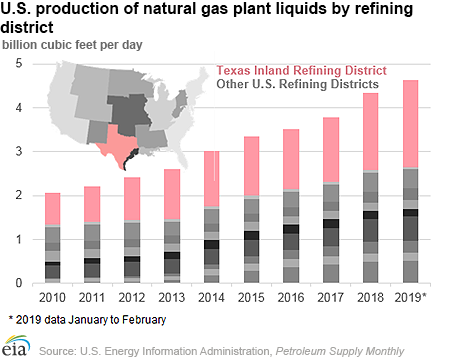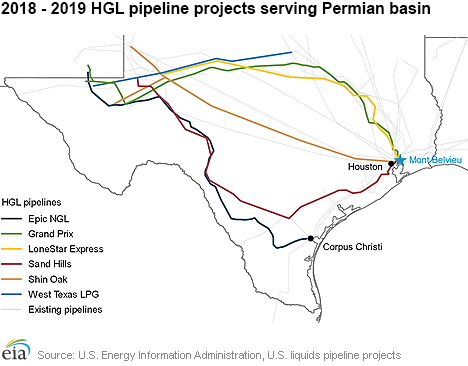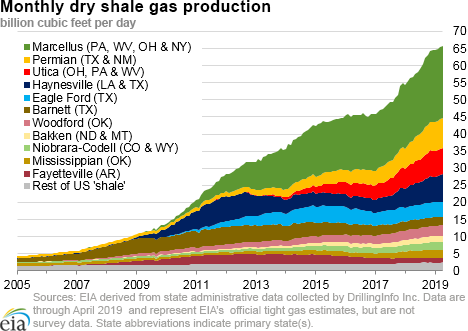In the News:
EIA publishes the U.S. Liquids Pipelines Projects Database
The U.S. Energy Information Administration (EIA) has released the first iteration of its U.S. liquids pipeline projects database on May 29, 2019. The database currently tracks more than 200 crude oil, HGL, and finished petroleum products pipeline projects. Data users will find project information―project type, start dates, capacity, mileage, and geographic information―for pipeline projects, including historical projects with completion dates starting in 2010.
The U.S. liquids pipeline database is intended to complement EIA’s existing natural gas pipeline projects database, which tracks current natural gas transmission pipeline projects in the United States.
Between 2010 and 2018, rapid growth in U.S. natural gas production was accompanied by an even larger increase in U.S. HGL production, which nearly doubled from 2.7 million barrels per day (b/d) in 2010 to 5.0 million b/d in 2018. Growth in HGL production occurred at natural gas processing plants, which recover ethane, propane, normal butane, isobutane, and natural gasoline (collectively referred to as natural gas plant liquids – NGPL) from wet natural gas before injecting pipeline-grade natural gas into the pipeline network.
In addition, most natural gas processing plants are also connected to HGL pipelines that ship a mixed NGPL stream, referred to as Y-grade, to fractionation plants for further processing into purity products. Because nearly all new HGL pipelines built since 2010 are designed to carry Y-grade from producing regions to fractionators on the Gulf Coast, EIA’s liquids pipeline database differentiates Y-grade pipelines from pipelines moving purity products.
The liquids pipeline projects database illustrates the infrastructure buildout in the Texas Inland Refining District, which encompasses the Delaware and Midland sections of the Permian Basin. Between 2010 and 2018, HGL production in the district rose by over 1 million b/d, from 730,000 b/d to 1.77 million b/d. Since the start of 2019, HGL production in the Texas Inland Refining District has averaged nearly 2.0 million b/d. As production growth outpaces pipeline capacity, and projections show continued growth in the region, midstream companies have responded with new pipeline capacity projects.
The Epic NGL, Shin Oak, Grand Prix, Lone Star Express, West Texas LPG, and Sand Hills pipelines are examples of current projects under development or construction to increase Y-grade transport options for Permian producers. Altogether, between 2018 and 2020 nearly 2 million b/d of additional Permian-to-Gulf-Coast Y-grade pipeline capacity is slated for completion, with most terminating at the Mont Belvieu, Texas HGL hub for fractionation, storage, and distribution.
Overview:
(For the week ending Wednesday, May 29, 2019)
- Natural gas spot prices rose at most locations this report week (Wednesday, May 22 to Wednesday, May 29). Henry Hub spot prices rose from $2.61 per million British thermal units (MMBtu) last Wednesday to $2.63/MMBtu yesterday.
- At the New York Mercantile Exchange (Nymex), the June 2019 contract expired yesterday at $2.633/MMBtu, up 9¢/MMBtu from last Wednesday. The July 2019 contract increased to $2.624/MMBtu, up 6¢/MMBtu from last Wednesday to yesterday. The price of the 12-month strip averaging July 2019 through June 2020 futures contracts climbed 3¢/MMBtu to $2.716/MMBtu.
- Net injections to working gas totaled 114 billion cubic feet (Bcf) for the week ending May 24. Working natural gas stocks are 1,867 Bcf, which is 9% more than the year-ago level and 12% lower than the five-year (2014–18) average for this week.
- The natural gas plant liquids composite price at Mont Belvieu, Texas, fell by 26¢/MMBtu, averaging $5.35/MMBtu for the week ending May 29. The price of propane, natural gasoline, butane, and isobutane fell by 8%, 7%, 2%, and 1%, respectively. The price of ethane rose by 1%.
- According to Baker Hughes, for the week ending Tuesday, May 21, the natural gas rig count increased by 1 to 186. The number of oil-directed rigs fell by 5 to 797. The total rig count decreased by 4, and it now stands at 983.
Prices/Supply/Demand:
Prices generally rise across the country. This report week (Wednesday, May 22 to Wednesday, May 29), Henry Hub spot prices stayed within a narrow range and rose 2¢ from $2.61/MMBtu last Wednesday to $2.63/MMBtu yesterday. Temperatures were cooler than normal west of the Mississippi River and warmer than normal in the eastern United States, particularly in the Mid-Atlantic and Southeast. At the Chicago Citygate, prices increased 14¢ from $2.29/MMBtu last Wednesday to a high of $2.43/MMBtu yesterday.
California prices mixed with cooler than normal temperatures. Prices at PG&E Citygate in Northern California rose 3¢, up from $3.23/MMBtu last Wednesday to $3.26/MMBtu yesterday. Prices at SoCal Citygate in Southern California decreased 24¢ from $2.74/MMBtu last Wednesday to a low of $2.50/MMBtu yesterday when temperatures were much cooler than normal.
Northeastern prices rise. At the Algonquin Citygate, which serves Boston-area consumers, prices went up 7¢ from $2.25/MMBtu last Wednesday to $2.32/MMBtu yesterday. At the Transcontinental Pipeline Zone 6 trading point for New York City, prices increased 6¢ from $2.27/MMBtu last Wednesday to a high of $2.33/MMBtu yesterday.
Tennessee Zone 4 Marcellus spot prices increased 6¢ from $2.13/MMBtu last Wednesday to a high of $2.19/MMBtu yesterday. Prices at Dominion South in southwest Pennsylvania rose 5¢ from $2.16/MMBtu last Wednesday to a high of $2.21/MMBtu yesterday.
Permian Basin prices reach a new record low as pipeline capacity reductions persist. Prices at the Waha Hub in West Texas, which is located near Permian Basin production activities, averaged $0.01/MMBtu last Wednesday, $2.60/MMBtu lower than Henry Hub prices. Yesterday, prices at the Waha Hub averaged –$0.80/MMBtu, $3.43/MMBtu lower than Henry Hub prices. They reached a record low of –$2.31/MMBtu on Friday amid ongoing restrictions on the Natural Gas Pipeline Company’s NGPL system. Continued maintenance and a force majeure issued yesterday are limiting northbound flows through Compressor Station 194 in Kansas, northwest of Wichita.
Supply rises with production growth. According to data from PointLogic Energy, the average total supply of natural gas rose by 1% compared with the previous report week. Dry natural gas production grew by 1% compared with the previous report week. Average net imports from Canada decreased by 2% from last week.
Demand rises driven by the electric power sector. Total U.S. consumption of natural gas rose by 2% compared with the previous report week, according to data from PointLogic Energy. Natural gas consumed for power generation climbed by 12% week over week with increased demand for cooling. Industrial sector consumption decreased by 2% week over week. In the residential and commercial sectors, consumption declined by 10%. Natural gas exports to Mexico increased 5%.
U.S. liquefied natural gas (LNG) exports flat week over week. Eleven LNG vessels (seven from Sabine Pass, two from Corpus Christi, and two from Cove Point), with a combined LNG-carrying capacity of 41.4 billion cubic feet (Bcf) departed the United States from May 23 to May 29, according to shipping data compiled by Bloomberg. Two vessels—one at Sabine Pass and one at a newly commissioned Cameron LNG facility in Louisiana—were loading at their respective terminals on Wednesday. This would be the first export cargo from the Cameron LNG project.
This week, Freeport LNG received an authorization from the U.S. Department of Energy to export LNG from Train 4 to countries with which the United States does not have a Free Trade Agreement (FTA). Freeport LNG currently has three trains under construction with a combined export capacity of 2 billion cubic feet per day (Bcf/d). Freeport Train 1 is currently undergoing commissioning and is expected to start LNG production in September 2019. Trains 2 and 3 are expected to be placed in service in the first and second quarters of 2020, respectively.
The latest information on the status of U.S. liquefaction facilities, including expected online dates and capacities, is available in EIA's database of U.S. LNG export facilities.
Storage:
Net injections into storage totaled 114 Bcf for the week ending May 24, compared with the five-year (2014–18) average net injections of 97 Bcf and last year's net injections of 95 Bcf during the same week. Working gas stocks totaled 1,867 Bcf, which is 257 Bcf lower than the five-year average and 156 Bcf more than last year at this time.
According to The Desk survey of natural gas analysts, estimates of the weekly net change from working natural gas stocks ranged from net injections of 94 Bcf to 111 Bcf, with a median estimate of 102 Bcf.
More storage data and analysis can be found on the Natural Gas Storage Dashboard and the Weekly Natural Gas Storage Report.
See also:
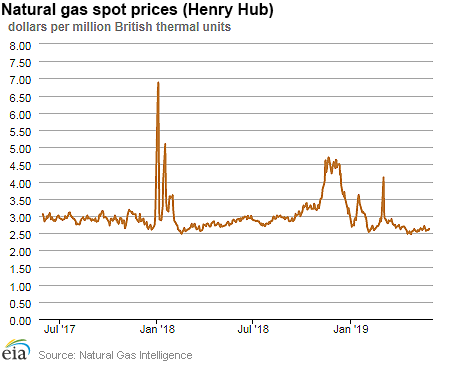
| Spot Prices ($/MMBtu) | Thu, 23-May |
Fri, 24-May |
Mon, 27-May |
Tue, 28-May |
Wed, 29-May |
|---|---|---|---|---|---|
| Henry Hub | 2.57 | 2.58 | Holiday | 2.60 | 2.63 |
| New York | 2.22 | 2.24 | Holiday | 2.30 | 2.33 |
| Chicago | 2.27 | 2.29 | Holiday | 2.36 | 2.43 |
| Cal. Comp. Avg.* | 2.61 | 2.41 | Holiday | 2.50 | 2.50 |
| Futures ($/MMBtu) | |||||
| June Contract | 2.578 | 2.598 | Holiday | 2.582 | 2.633 |
| July Contract | 2.592 | 2.611 | Holiday | 2.584 | 2.624 |
| *Avg. of NGI's reported prices for: Malin, PG&E Citygate, and Southern California Border Avg. | |||||
| Sources: Natural Gas Intelligence and CME Group as compiled by Bloomberg, L.P. | |||||
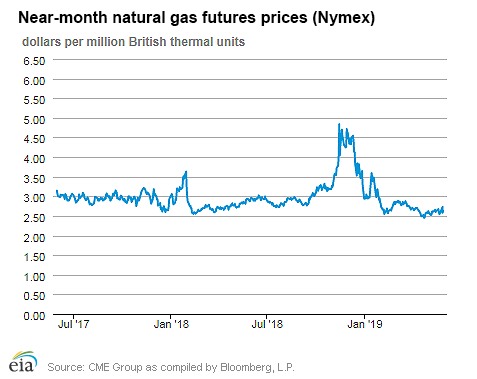
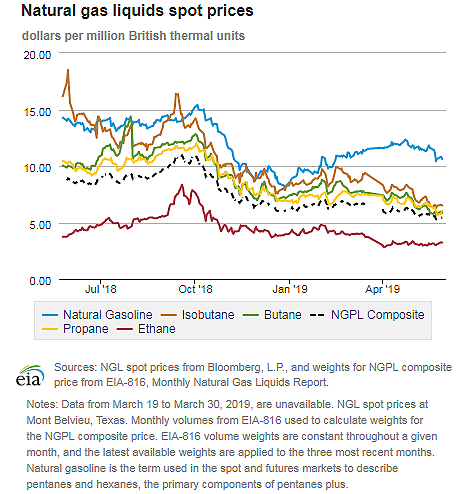
| U.S. natural gas supply - Gas Week: (5/23/19 - 5/29/19) | |||
|---|---|---|---|
Average daily values (Bcf/d): |
|||
this week |
last week |
last year |
|
| Marketed production | 100.4 |
99.3 |
91.5 |
| Dry production | 89.5 |
88.6 |
81.6 |
| Net Canada imports | 4.9 |
4.9 |
6.2 |
| LNG pipeline deliveries | 0.1 |
0.1 |
0.1 |
| Total supply | 94.5 |
93.6 |
87.9 |
|
Source: OPIS PointLogic Energy, an IHS Company | |||
| U.S. natural gas consumption - Gas Week: (5/23/19 - 5/29/19) | |||
|---|---|---|---|
Average daily values (Bcf/d): |
|||
this week |
last week |
last year |
|
| U.S. consumption | 62.2 |
60.7 |
60.3 |
| Power | 29.9 |
26.7 |
28.7 |
| Industrial | 21.1 |
21.5 |
21.2 |
| Residential/commercial | 11.2 |
12.4 |
10.5 |
| Mexico exports | 4.8 |
4.6 |
4.5 |
| Pipeline fuel use/losses | 6.0 |
6.0 |
5.6 |
| LNG pipeline receipts | 5.8 |
5.6 |
2.8 |
| Total demand | 78.8 |
76.9 |
73.3 |
|
Source: OPIS PointLogic Energy, an IHS Company | |||
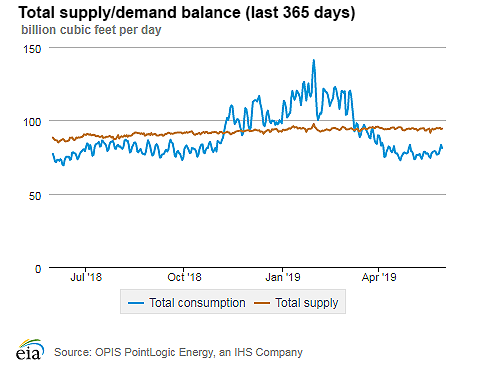
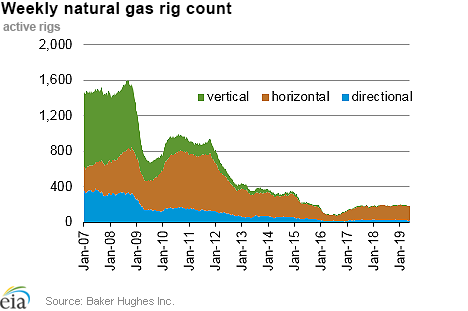
| Rigs | |||
|---|---|---|---|
Tue, May 21, 2019 |
Change from |
||
last week |
last year |
||
| Oil rigs | 797 |
-0.6% |
-7.2% |
| Natural gas rigs | 186 |
0.5% |
-6.1% |
| Note: Excludes any miscellaneous rigs | |||
| Rig numbers by type | |||
|---|---|---|---|
Tue, May 21, 2019 |
Change from |
||
last week |
last year |
||
| Vertical | 51 |
6.3% |
-22.7% |
| Horizontal | 863 |
-0.3% |
-6.8% |
| Directional | 69 |
-5.5% |
3.0% |
| Source: Baker Hughes Inc. | |||
| Working gas in underground storage | ||||
|---|---|---|---|---|
Stocks billion cubic feet (Bcf) |
||||
| Region | 2019-05-24 |
2019-05-17 |
change |
|
| East | 383 |
353 |
30 |
|
| Midwest | 399 |
364 |
35 |
|
| Mountain | 93 |
89 |
4 |
|
| Pacific | 198 |
186 |
12 |
|
| South Central | 793 |
762 |
31 |
|
| Total | 1,867 |
1,753 |
114 |
|
|
Source: Form EIA-912, Weekly Underground Natural Gas Storage Report | ||||
| Working gas in underground storage | |||||
|---|---|---|---|---|---|
Historical comparisons |
|||||
Year ago (5/24/18) |
5-year average (2014-2018) |
||||
| Region | Stocks (Bcf) |
% change |
Stocks (Bcf) |
% change |
|
| East | 324 |
18.2 |
397 |
-3.5 |
|
| Midwest | 311 |
28.3 |
444 |
-10.1 |
|
| Mountain | 112 |
-17.0 |
136 |
-31.6 |
|
| Pacific | 220 |
-10.0 |
254 |
-22.0 |
|
| South Central | 744 |
6.6 |
893 |
-11.2 |
|
| Total | 1,711 |
9.1 |
2,124 |
-12.1 |
|
| Source: Form EIA-912, Weekly Underground Natural Gas Storage Report | |||||
| Temperature – heating & cooling degree days (week ending May 23) | ||||||||
|---|---|---|---|---|---|---|---|---|
HDD deviation from: |
CDD deviation from: |
|||||||
| Region | HDD Current |
normal |
last year |
CDD Current |
normal |
last year |
||
| New England | 36 |
-15 |
-15 |
4 |
2 |
3 |
||
| Middle Atlantic | 18 |
-22 |
-11 |
10 |
3 |
7 |
||
| E N Central | 41 |
-4 |
4 |
9 |
-5 |
3 |
||
| W N Central | 65 |
25 |
34 |
10 |
-7 |
-11 |
||
| South Atlantic | 2 |
-13 |
0 |
70 |
25 |
9 |
||
| E S Central | 0 |
-14 |
-1 |
66 |
31 |
8 |
||
| W S Central | 1 |
-1 |
1 |
85 |
22 |
8 |
||
| Mountain | 102 |
49 |
63 |
3 |
-21 |
-17 |
||
| Pacific | 73 |
40 |
41 |
0 |
-8 |
-1 |
||
| United States | 40 |
6 |
14 |
31 |
6 |
3 |
||
|
Note: HDD = heating degree day; CDD = cooling degree day Source: National Oceanic and Atmospheric Administration | ||||||||
Average temperature (°F)
7-day mean ending May 23, 2019
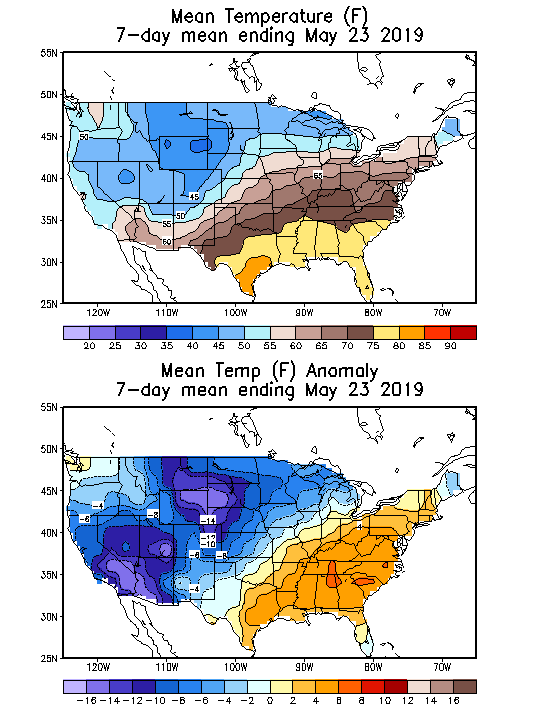
Source: National Oceanic and Atmospheric Administration
Deviation between average and normal (°F)
7-day mean ending May 23, 2019

Source: National Oceanic and Atmospheric Administration

